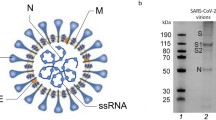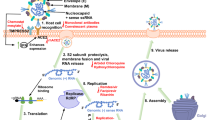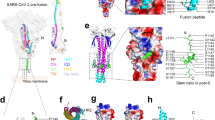Abstract
Background
Severe acute respiratory syndrome (SARS) is a febrile respiratory illness. The disease has been etiologically linked to a novel coronavirus that has been named the SARS-associated coronavirus (SARS-CoV), whose genome was recently sequenced. Since it is a member of the Coronaviridae, its spike protein (S2) is believed to play a central role in viral entry by facilitating fusion between the viral and host cell membranes. The protein responsible for viral-induced membrane fusion of HIV-1 (gp41) differs in length, and has no sequence homology with S2.
Results
Sequence analysis reveals that the two viral proteins share the sequence motifs that construct their active conformation. These include (1) an N-terminal leucine/isoleucine zipper-like sequence, and (2) a C-terminal heptad repeat located upstream of (3) an aromatic residue-rich region juxtaposed to the (4) transmembrane segment.
Conclusions
This study points to a similar mode of action for the two viral proteins, suggesting that anti-viral strategy that targets the viral-induced membrane fusion step can be adopted from HIV-1 to SARS-CoV. Recently the FDA approved Enfuvirtide, a synthetic peptide corresponding to the C-terminal heptad repeat of HIV-1 gp41, as an anti-AIDS agent. Enfuvirtide and C34, another anti HIV-1 peptide, exert their inhibitory activity by binding to a leucine/isoleucine zipper-like sequence in gp41, thus inhibiting a conformational change of gp41 required for its activation. We suggest that peptides corresponding to the C-terminal heptad repeat of the S2 protein may serve as inhibitors for SARS-CoV entry.
Similar content being viewed by others
Background
Infection by many enveloped viruses requires fusion of the viral and cellular membranes. A viral envelope protein mediates this membrane fusion process. These proteins are synthesized as precursors (ENV in Retroviridae, and E2 in Coronaviridae) that are later processed into a transmembrane subunit (gp41 in the retrovirus HIV-1, and S2 in the coronavirus SARS-CoV) that is responsible for viral-induced membrane fusion, and a surface subunit that is responsible for the interaction with the cellular receptor/s.
HIV-1 gp41, which is a well-characterized protein [1, 2] contains two heptad repeat (HR) regions, a leucine/isoleucine HR adjacent to its N-terminus (N-HR), and C-HR proximal to the transmembrane domain (see Figure 1). Heptad repeats are characterized by hydrophobic amino acids in the "a" and "d" positions of the helix. In the N-HR of gp41, all but one of the "a" positions are Leucines or Isoleucines. This feature is less strict in the "d" positions of N-HR, and in the "a" and "d" positions of the C-HR. Peptides corresponding to these heptad repeat regions form the "trimer-of-hairpins" core structure of gp41 [3] as confirmed by the solution of the crystal structures [1, 2]. Two Cysteine residues and one Proline residue, located between these two HRs, confine a hairpin conformation (Figure 2a). A tryptophan-rich motif, located between the C-HR and the transmembrane domain, was shown to play a crucial role in gp41-mediated membrane fusion [4] (Figure 2a).
Wheel projection of the N-HR (a) and C-HR (b) of HIV-1 gp41 (gi|9629363). The amino acid sequence is displayed end-to-end down the axis of a schematic helix. The angle between every two consecutive amino acids is 102.9°. The helical wheel consists of seven corners, corresponding to the fit of seven amino acid residues into every two helical turns.
Similarity between the fusion proteins of HIV-1 and SARS-CoV. The HIV-1 gp41 (a) and the equivalent S2 protein from the SARS-CoV (b) are shown. A Leucine/Isoleucine heptad repeat adjacent to the N-terminus of both proteins appears in red. The C-terminal heptad repeat is in green. Cysteine residues (purple) confining a loop structure are located between the two heptad repeats. An aromatic residues-rich motif is marked blue, and the transmembrane segment is in orange. A peptide corresponding to the C-terminal heptad repeat, which acts as potent inhibitor of HIV-1 entry into the cell, appears in yellow.
In order to exert their role in membrane fusion, viral spike proteins act as oligomers and go through a significant conformational change resulting in the "trimer-of-hairpin" conformation. The oligomerization and the change in conformation of viral spike proteins involve interactions between proteins segments. Peptides derived from a segment of this protein might therefore interfere with one of these processes, and inhibit viral infection. Indeed, peptides corresponding to the C-HR of gp41 are potent inhibitors of HIV-1 entry into cells, one of them, Enfuvirtide (Fuzeon), was recently approved by the FDA as an addition to the cocktail currently given to AIDS patients [5], and C34, a peptide corresponding to the C-HR of the gp41 core complex is promising in-vitro [1]. It is believed that these peptides exert their anti-viral activity via a dominant negative mechanism by interacting with the central N-HR segment of gp41 [6]. This is a promising approach also in developing anti-viral peptides against several paramyxoviruses [7].
The genome of the SARS-CoV was recently sequenced [8, 9]. Since it is a member of the Coronaviridae [10], the S2 protein is believed to play a central role in viral entry. Although we found no sequence homology between the SARS-CoV S2 and HIV-1 gp41, a comprehensive sequence analysis reveals that all the above-mentioned elements of gp41 are present also in S2.
In analogy to HIV-1 gp41, N-HR and an aromatic-rich region in SARS-CoV S2 protein were identified by Gallaher & Garry [11]. Whereas these discoveries have structural importance, peptides corresponding to the N-HR of HIV-1 [12] and Sendai virus [13], and to the aromatic-rich region of feline immunodeficiency virus [14] were found to have only low anti-viral activity, compared to the highly active C-HR corresponding peptides.
Herein, we report the identification of the sequence in SARS-CoV S2 protein that is analogous to the C-HR of HIV-1 gp41. This led us to the suggestion that the viral entry mechanisms are analogous and therefore a therapeutic strategy that is being applied against the HIV-1 can be adopted to fight SARS-CoV.
Results and discussion
Coronaviridae S2 proteins are believed to be functionally equivalent to the transmembrane subunits of Retroviral ENV. However, using well-known sequence comparison algorithms [15, 16], we found that there is no sequence homology between the S2 protein of SARS-CoV and HIV-1 gp41.
Markedly, LearnCoil-VMF [17], helical wheel analysis and protein topology prediction [18] reveal that the SARS-CoV S2 protein consists of the same elements that were characterized in HIV-1 gp41 (Figure 2b): (I) N-HR, a Leucine/Isoleucine heptad repeat appears on residues 913–1000 of the SARS-CoV CUHK-W1 isolate (Figure 3a).; (II) C-HR, a Leucine/Isoleucine heptad repeat appears on residues 1151–1185 (Figure 3b); (III) the loop between these two HRs is longer than that of gp41, and is confined by four Cysteine residues and nine Proline residues that might conform a double loop structure; (IV) a transmembrane region is predicted adjacent to the C-terminus of the protein [18]; (V) a Tryptophan/Tyrosine-rich motif is located between the C-HR and the transmembrane domain (Figure 4). The results reveal similar structural motifs in HIV-1 gp41 and SARS-CoV S2 proteins, suggesting an analogous membrane fusion mechanism induced by the two viruses.
Wheel projection of the N-HR (a) and C-HR (b) of SARS-CoV S2 protein (gi|30023954). The amino acid sequence is displayed end-to-end down the axis of a schematic helix. The angle between every two consecutive amino acids is 102.9°. The helical wheel consists of seven corners, corresponding to the fit of seven amino acid residues into every two helical turns.
The helical wheel diagram serves as an equivalent to the Spartan scytale, the first military cryptographic device, consisting of a cylinder with a strip of paper wound around it. The recipient has a rod of the same diameter, on which he wraps the paper to read the message. Herein, the prior knowledge of the 3.5 periodicity learned from the HIV-1 gp41 structural studies, is used to decipher the structural features of the SARS-CoV S2 protein.
In general, SARS-CoV S2 and HIV-1 gp41 share the hairpin structure. However, it is worth noting that the N-HR of S2 is longer than that of gp41 and contains more Leucines and Isoleucines. Furthermore, while the C-HR of gp41 barely shows any heptad repeat signal, the C-HR of S2 has a perfect Leucine/Isoleucine heptad repeat in its "d" positions.
The antiviral activity of Enfuvirtide was reported as early as 1993 [19], while it took few years until the fold of gp41 core complex was discovered [3] and its crystal structure being solved [1, 2]. Based on these structural studies, peptides corresponding to the C-HR of gp41 core complex, such as C34, were synthesized and found to efficiently inhibit HIV-1 induced membrane fusion [1]. Interestingly, Enfuvirtide, which is a shifted version of these C-peptides, does not comprise the residues that were shown to be essential for their inhibitory activity [20]. Indeed, others and myself reported that in some cases C34 is more potent in inhibiting HIV-1 gp41 induced membrane fusion than Enfuvirtide [21, 22]. Thus, the SARS-CoV sequence corresponding to C34 has higher chances to block SARS-CoV entry.
Conclusions
Based on the similarity in the mechanisms in which the two viruses induce fusion between their membrane and their host cell membrane, we propose adapting the successful anti-fusion therapeutic approach used against HIV-1 to the SARS-CoV case. Peptides derived from the C-HR segment of SARS-CoV S2 protein (ISGINASVVNIQKEIDRLNEVAKNLNESLIDLQEL) might inhibit viral induced membrane fusion, thereby blocking SARS-CoV infection. As the SARS-CoV infects respiratory tissues, the classical disadvantages of peptide therapeutics administration may be overcome using intranasal delivery [23].
Methods
Heptad repeat analysis
LearnCoil-VMF program [17] and helical wheel diagrams, with 3.5 amino acid per residue, were used to detect coiled-coil regions in the SARS-CoV S2 protein.
Transmembrane domain prediction
HMMTOP program [18] was used to predict the location of transmembrane regions in the SARS-CoV S2 protein.
Protein sequences
SARS-CoV genomic sequence information (NC_004718) was retrieved from GenBank at the National Center for Biotechnology Information (NCBI). The SARS-CoV E2 precursor protein accession number is gi|30023954. This precursor is believed to be post-translationally processed to reveal S1 and S2, as confirmed in other Coronaviridae viruses.
The HIV-1 gp160 precursor protein sequence used here is gi|9629363. Gp41 starts at residue 512, after the basic cleavage site.
Abbreviations
- SARS-CoV:
-
Severe Acute Respiratory Syndrome Coronaviridae Virus.
- FDA:
-
US Food & Drug Administration.
- HIV-1:
-
Human Immunodeficiency Virus Type 1.
- HR:
-
Heptad Repeat.
References
Chan DC, Fass D, Berger JM, Kim PS: Core structure of gp41 from the HIV envelope glycoprotein. Cell. 1997, 89: 263-273.
Weissenhorn W, Dessen A, Harrison SC, Skehel JJ, Wiley DC: Atomic structure of the ectodomain from HIV-1 gp41. Nature. 1997, 387: 426-430. 10.1038/387426a0.
Lu M, Blacklow SC, Kim PS: A trimeric structural domain of the HIV-1 transmembrane glycoprotein. Nat Struct Biol. 1995, 2: 1075-1082.
Salzwedel K, West JT, Hunter E: A conserved tryptophan-rich motif in the membrane-proximal region of the human immunodeficiency virus type 1 gp41 ectodomain is important for Env-mediated fusion and virus infectivity. J Virol. 1999, 73: 2469-2480.
LaBonte J, Lebbos J, Kirkpatrick P: Enfuvirtide. Nature Reviews Drug Discovery. 2003, 2: 345-10.1038/nrd1091.
Chan DC, Kim PS: HIV entry and its inhibition. Cell. 1998, 93: 681-684.
Lambert DM, Barney S, Lambert AL, Guthrie K, Medinas R, Davis DE, Bucy T, Erickson J, Merutka G, Petteway S. R., Jr.: Peptides from conserved regions of paramyxovirus fusion (F) proteins are potent inhibitors of viral fusion. Proc Natl Acad Sci U S A. 1996, 93: 2186-2191. 10.1073/pnas.93.5.2186.
Marra MA, Jones SJ, Astell CR, Holt RA, Brooks-Wilson A, Butterfield YS, Khattra J, Asano JK, Barber SA, Chan SY, Cloutier A, Coughlin SM, Freeman D, Girn N, Griffith OL, Leach SR, Mayo M, McDonald H, Montgomery SB, Pandoh PK, Petrescu AS, Robertson AG, Schein JE, Siddiqui A, Smailus DE, Stott JM, Yang GS, Plummer F, Andonov A, Artsob H, Bastien N, Bernard K, Booth TF, Bowness D, Czub M, Drebot M, Fernando L, Flick R, Garbutt M, Gray M, Grolla A, Jones S, Feldmann H, Meyers A, Kabani A, Li Y, Normand S, Stroher U, Tipples GA, Tyler S, Vogrig R, Ward D, Watson B, Brunham RC, Krajden M, Petric M, Skowronski DM, Upton C, Roper RL: The Genome sequence of the SARS-associated coronavirus. Science. 2003, 300: 1399-1404. 10.1126/science.1085953.
Rota PA, Oberste MS, Monroe SS, Nix WA, Campagnoli R, Icenogle JP, Penaranda S, Bankamp B, Maher K, Chen MH, Tong S, Tamin A, Lowe L, Frace M, DeRisi JL, Chen Q, Wang D, Erdman DD, Peret TC, Burns C, Ksiazek TG, Rollin PE, Sanchez A, Liffick S, Holloway B, Limor J, McCaustland K, Olsen-Rasmussen M, Fouchier R, Gunther S, Osterhaus AD, Drosten C, Pallansch MA, Anderson LJ, Bellini WJ: Characterization of a novel coronavirus associated with severe acute respiratory syndrome. Science. 2003, 300: 1394-1399. 10.1126/science.1085952.
Peiris JS, Lai ST, Poon LL, Guan Y, Yam LY, Lim W, Nicholls J, Yee WK, Yan WW, Cheung MT, Cheng VC, Chan KH, Tsang DN, Yung RW, Ng TK, Yuen KY: Coronavirus as a possible cause of severe acute respiratory syndrome. Lancet. 2003, 361: 1319-1325. 10.1016/S0140-6736(03)13077-2.
Gallaher WR, Garry RF: Model of the pre-insertion region of the spike (S2) fusion glycoprotein of the human SARS coronavirus: implications for antiviral therapeutics.http://www.virology.net/sars/s2model.html
Wild CT, Shugars DC, Greenwell TK, McDanal CB, Matthews TJ: Peptides corresponding to a predictive alpha-helical domain of human immunodeficiency virus type 1 gp41 are potent inhibitors of virus infection. Proc Natl Acad Sci U S A. 1994, 91: 9770-9774.
Rapaport D, Ovadia M, Shai Y: A synthetic peptide corresponding to a conserved heptad repeat domain is a potent inhibitor of Sendai virus-cell fusion: an emerging similarity with functional domains of other viruses. Embo J. 1995, 14: 5524-5531.
Giannecchini S, Di Fenza A, D'Ursi AM, Matteucci D, Rovero P, Bendinelli M: Antiviral activity and conformational features of an octapeptide derived from the membrane-proximal ectodomain of the feline immunodeficiency virus transmembrane glycoprotein. J Virol. 2003, 77: 3724-3733. 10.1128/JVI.77.6.3724-3733.2003.
Altschul SF, Gish W, Miller W, Myers EW, Lipman DJ: Basic local alignment search tool. J Mol Biol. 1990, 215: 403-410. 10.1006/jmbi.1990.9999.
Needleman SB, Wunsch CD: A general method applicable to the search for similarities in the amino acid sequence of two proteins. J Mol Biol. 1970, 48: 443-453.
Singh M, Berger B, Kim PS: LearnCoil-VMF: computational evidence for coiled-coil-like motifs in many viral membrane-fusion proteins. J Mol Biol. 1999, 290: 1031-1041. 10.1006/jmbi.1999.2796.
Tusnady GE, Simon I: The HMMTOP transmembrane topology prediction server. Bioinformatics. 2001, 17: 849-850. 10.1093/bioinformatics/17.9.849.
Wild C, Greenwell T, Matthews T: A synthetic peptide from HIV-1 gp41 is a potent inhibitor of virus-mediated cell-cell fusion. AIDS Res Hum Retroviruses. 1993, 9: 1051-1053.
Chan DC, Chutkowski CT, Kim PS: Evidence that a prominent cavity in the coiled coil of HIV type 1 gp41 is an attractive drug target. Proc Natl Acad Sci U S A. 1998, 95: 15613-15617. 10.1073/pnas.95.26.15613.
Xu Y, Zhang X, Matsuoka M, Hattori T: The possible involvement of CXCR4 in the inhibition of HIV-1 infection mediated by DP178/gp41. FEBS Lett. 2000, 487: 185-188. 10.1016/S0014-5793(00)02336-X.
Kliger Y, Gallo SA, Peisajovich SG, Munoz-Barroso I, Avkin S, Blumenthal R, Shai Y: Mode of action of an antiviral peptide from HIV-1. Inhibition at a post-lipid mixing stage. J Biol Chem. 2001, 276: 1391-1397. 10.1074/jbc.M004113200.
Pastey MK, Gower TL, Spearman PW, Crowe J. E., Jr., Graham BS: A RhoA-derived peptide inhibits syncytium formation induced by respiratory syncytial virus and parainfluenza virus type 3. Nat Med. 2000, 6: 35-40. 10.1038/71503.
Acknowledgements
We thank Eli Eisenberg, Salomon Langer, Rodrigo Yelin, Moshe Olshansky and Rotem Sorek for helpful discussions. We are also grateful to Amit Rubinfeld for technical help.
Author information
Authors and Affiliations
Corresponding author
Additional information
Authors' contributions
Y.K. was responsible for the initiation of this project. E.Y.L. & Y.K. carried out the technical work, analyzed the data, drafted the manuscript and approved the final manuscript.
Authors’ original submitted files for images
Below are the links to the authors’ original submitted files for images.
Rights and permissions
This article is published under an open access license. Please check the 'Copyright Information' section either on this page or in the PDF for details of this license and what re-use is permitted. If your intended use exceeds what is permitted by the license or if you are unable to locate the licence and re-use information, please contact the Rights and Permissions team.
About this article
Cite this article
Kliger, Y., Levanon, E.Y. Cloaked similarity between HIV-1 and SARS-CoV suggests an anti-SARS strategy. BMC Microbiol 3, 20 (2003). https://doi.org/10.1186/1471-2180-3-20
Received:
Accepted:
Published:
DOI: https://doi.org/10.1186/1471-2180-3-20








